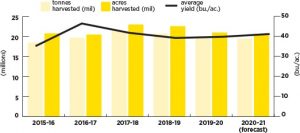Canola Market Snapshot
The European Union entered a new status level for Canadian canola purchases in 2019-20, and it means we can start talking about the “Big 5” instead of the “Big 4”. The EU bought 2.1 million tonnes of Canadian canola seed in 2019-20 worth over $1 billion, moving it ahead of Mexico and just behind Japan. (See Figure 1.) Growth in Canadian canola seed sales to Europe is driven by special export programs that certify Canadian canola growers as meeting EU standards for biofuels feedstock.
The U.S. remains the top market for Canadian canola products, especially oil and meal. Though the value of sales to China dropped to $2.4 billion in 2019-20, driven down by continued suspension of seed export licenses for Viterra and Richardson, China remains a very important customer.
All yield for 2019-20, according to Statistics Canada, was 41.1 bu./ac. – which is on par with the five-year average. (See Figure 3.) A big question for Canada’s canola industry is why average yields have been basically flat for five years. A Canola Council of Canada grower survey this winter, the first comprehensive survey of canola production practices since 2011-12, should help answer this question.
Global vegetable oil production keeps rising
The USDA, in its September 2020 “Oilseeds: World Market and Trade” report, projects global oilseed production for 2020-21 at 609 million tonnes. This marks a return to the usual growth trend after a blip last year where global production was only 577 million tonnes, down from 601 the year before.
| Country | 2019-20 | 2018-19 | 2017-18 | 2016-17 | 2015-16 |
|---|---|---|---|---|---|
| (millions of Canadian dollars) | |||||
| Crop Year (August to July) | |||||
| TOTAL | $10,568 | $10,063 | $11,120 | $11,056 | $9,789 |
| United States | $3,614 | $3,442 | $3,645 | $3,772 | $3,408 |
| China | $2,444 | $3,218 | $3,790 | $3,369 | $2,746 |
| Japan | $1,195 | $1,181 | $1,480 | $1,234 | $1,213 |
| European Union | $1,079 | $319 | $205 | $446 | $281 |
| Mexico | $730 | $774 | $888 | $928 | $803 |
| Other | $1,506 | $1,129 | $1,112 | $1,307 | $1,338 |
| 2019-20 | 2018-19 | 2017-18 | 2016-17 | 2015-16 | |
|---|---|---|---|---|---|
| Product | (Millions of Canadian dollars) | ||||
| Crop Year (August to July) | |||||
| TOTAL | $10,568.4 | $10,062.8 | $11,119.8 | $11,056.5 | $9,789.1 |
| Seed | $5,192.6 | $5,001.3 | $6,079.7 | $6,060.6 | $5,516.2 |
| Oil | $3,621.7 | $3,395.6 | $3,416.6 | $3,422.7 | $2,855.4 |
| Meal | $1,754.1 | $1,665.9 | $1,623.5 | $1,573.2 | $1,417.5 |
Soybeans are by far the biggest oilseed crop, accounting for 370 million of the 609 million. Canola/rapeseed is second at 68 million, but that is the lowest global canola/rapeseed output over the past five years. Palm oil, not included in the oilseed numbers, is still the biggest volume vegetable oil in the world – and its annual production keeps increasing. The September USDA forecast for 2020-21 is 75 million tonnes of palm oil compared to 60 million of soybean oil and 27 million of canola/rapeseed oil. Over the past five years, canola/rapeseed oil production is basically flat while soybean and palm oil production are rising. Soybean and canola meal production follow the same trend lines.

Notable second wave markets
The value of sales to markets outside of the Big 4 crossed the $1 billion mark in 2015-16 and blew past the $2 billion mark in 2019-20, reaching $2.6 billion. The EU accounted for a large percentage of this, with over a billion dollars in Canadian canola seed purchases. Other notable seed markets are United Arab Emirates, which increased its purchases to around $500 million, Pakistan, which has become a reliable market for $400 to $500 million each year, and Bangladesh at $160 million. For bulk shipments of Canadian canola oil, South Korea has become a reliable market for over $100 million each year and Chile is steadily rising. Chile was actually our third biggest market for canola oil in 2019-20, buying $141 million worth. While Chile is still well behind the U.S. and China, sales to Chile symbolize good growth in second wave markets all around the world.




